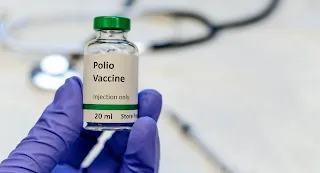What is Polio? Discuss its symptoms, causes of spreading, prevention and vaccine.
 |
| What is Polio? Discuss its symptoms, causes of spreading, prevention and vaccine. |
Polio, short for
poliomyelitis, is a highly infectious viral disease caused by the poliovirus.
It mainly affects the nervous system, potentially leading to paralysis or even
death. Prior to the development of the polio vaccine, it was a major global
health concern, particularly affecting children. Fortunately, concerted global
vaccination efforts have led to a significant reduction in polio cases
worldwide.
Symptoms:
Polio can manifest in various
ways, depending on the severity of the infection:
- Asymptomatic:
In many cases, people infected with the poliovirus may not show any
symptoms (about 95% of cases). However, even asymptomatic individuals can
still spread the virus to others.
- Non-paralytic polio:
Some infected individuals may experience mild flu-like symptoms such as
fever, headache, sore throat, fatigue, nausea, and vomiting. This form of
polio is referred to as non-paralytic or abortive polio.
- Paralytic polio:
In rare cases (less than 1% of infections), the virus invades the central
nervous system, leading to more severe symptoms, including muscle weakness
or paralysis. Paralytic polio can be further categorized into spinal polio
(affects motor neurons in the spinal cord), bulbar polio (affects cranial
nerves), and bulbospinal polio (affects both cranial and spinal nerves).
Causes of spreading:
Polio spreads through the
fecal-oral route, primarily through contaminated food, water, or surfaces. The
virus enters the body through the mouth and multiplies in the throat and
intestines. From there, it can enter the bloodstream and travel to the central
nervous system, potentially leading to paralysis.
Prevention:
Preventing polio involves
several measures:
- Vaccination:
The most effective way to prevent polio is through vaccination. The oral
polio vaccine (OPV) and the inactivated polio vaccine (IPV) are two
commonly used vaccines. Both vaccines stimulate the body's immune system
to produce antibodies against the virus, providing protection from
infection.
- Hygiene and sanitation:
Ensuring clean drinking water and proper sanitation practices help reduce
the risk of polio transmission through contaminated sources.
- Personal hygiene:
Encouraging regular handwashing, especially after using the bathroom and
before eating, can minimize the risk of infection.
- Isolation:
Infected individuals should be isolated to prevent the spread of the virus
to others.
Vaccine:
There are two main types of
polio vaccines:
- Oral Polio Vaccine (OPV):
OPV is a live attenuated vaccine that contains weakened poliovirus
strains. It is administered orally, usually in drops, and provides
excellent immunity not only to the vaccinated individual but also creates
immunity in the intestines, reducing the spread of the virus in the
community.
- Inactivated Polio Vaccine (IPV):
IPV is an injectable vaccine that contains inactivated (killed) poliovirus
strains. It stimulates the production of antibodies in the bloodstream,
providing protection against paralytic polio.
Global Polio Eradication Initiative
(GPEI):
The GPEI is a collaboration
between various organizations, including the World Health Organization (WHO),
UNICEF, Rotary International, the Centers for Disease Control and Prevention
(CDC), and the Bill & Melinda Gates Foundation. Its goal is to eradicate
polio worldwide through vaccination campaigns, surveillance, and containment
measures.
Due to the concerted efforts
of the GPEI and other health organizations, polio has been eliminated in many
parts of the world. However, it remains essential to maintain vaccination
efforts and surveillance to prevent any potential resurgence of the disease.
